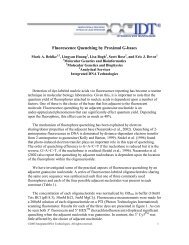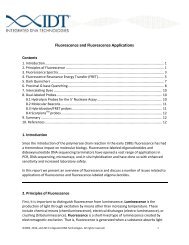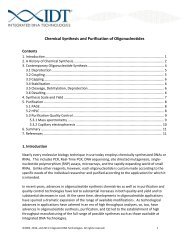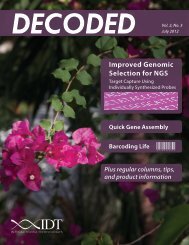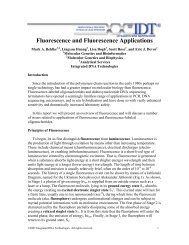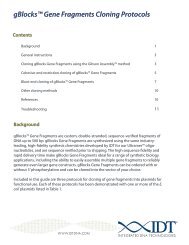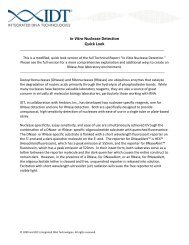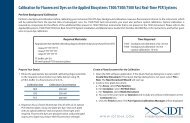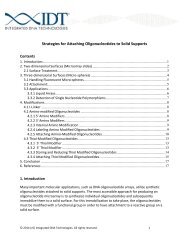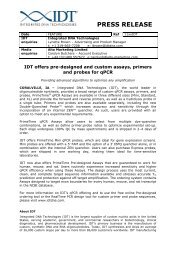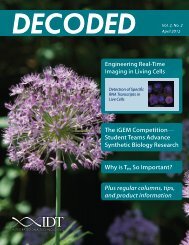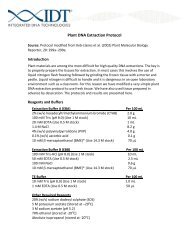Improved Print and QC Methods for Oligonucleotide Arrays
Improved Print and QC Methods for Oligonucleotide Arrays
Improved Print and QC Methods for Oligonucleotide Arrays
Create successful ePaper yourself
Turn your PDF publications into a flip-book with our unique Google optimized e-Paper software.
To determine if array spot quality asvisualized using the IDT <strong>QC</strong> reagent hasutility in predicting the quality of arrayper<strong>for</strong>mance in real target hybridizations, wecompared the <strong>QC</strong> image obtained from aPCR product array with the image obtainedafter actual hybridization with labeledcellular RNAs (Figure 6). In mostinstances, the spot signal intensities from thetwo-color hybridization experiment mirrorthe spot signal intensities from the IDTCy3-nonamer <strong>QC</strong> hybridization. Notethat several spots are “missing” in bothimages. In several cases (see arrows), the<strong>QC</strong> reagent visualized probe spots that werenot seen in actual target RNA hybridization,presumably due to low representation ofthese specific RNA species in the target mix.Significantly, no cases were observed wherePCR product probe spots were detected inthe “real hybridization” <strong>and</strong> absent in the<strong>QC</strong> hybridization. There<strong>for</strong>e the “missingspots” were successfully identified as either“print dropouts” or “target absence” usingthis <strong>QC</strong> method. The ability to discriminatebetween these two events is a critical goal ofarray <strong>QC</strong> analysis since it allows <strong>for</strong>meaningful interpretation of negativehybridization data. Thus, the IDTCy3-nonamer offers greater power <strong>for</strong>array <strong>QC</strong>, with improved sensitivity <strong>and</strong>more accurate assessment of spotted probequality as well as functional availability <strong>for</strong>hybridization.1-u1-a1-h1-A1-H7-u7-a7-hSigmaHybChecker(Cy5 replacement)[?µM]Molecular ProbesAlexa-546 Panomer(Cy3 )[7.5µM]GenetixSpotCheck(Cy3 )[10µM]TeleChemSeeIt(Cy3 )[10µM]IDT Nonamer(Cy3 )[2µM]Figure 4: Comparison of Nonamer <strong>QC</strong> Products. 70mer oligoprobes (1 is 25.7% GC <strong>and</strong> 7 is 55.7% GC) were printed @25µM using IDT’sOSB print buffer on UltraGAPS slides with a 3 hour humidity treatment <strong>and</strong>no heat coupling. Images are 5µm resolution scans using a ScanArray® 5000(Perkin Elmer) at 80/80 laser (power/gain) settings with the Cy5-channel <strong>for</strong>the Sigma HybChecker <strong>and</strong> 73/73 laser (power/gain) settings with theCy3-channel <strong>for</strong> all others. Bold, black arrows indicate low GC-contentprobe-oligos immobilized on surface at low probe-density. (Pseudo-color scale:black



